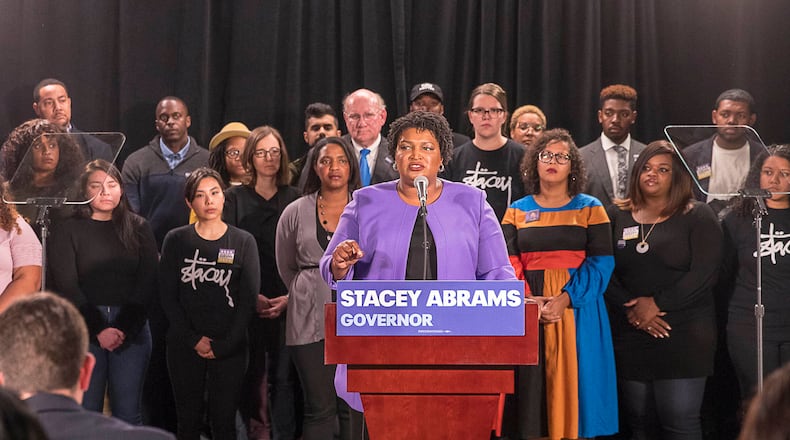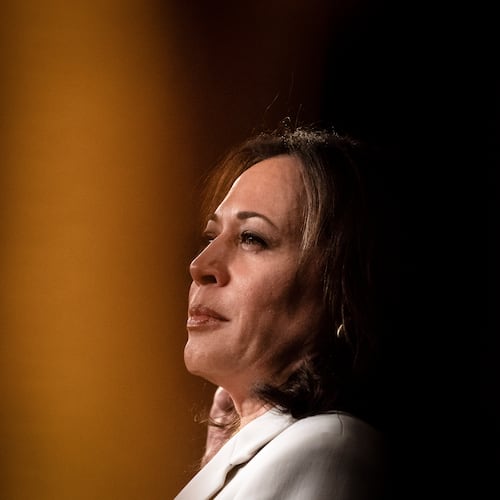In the tense days before the May primary, poll after poll showed Stacey Abrams with a steady, if not overwhelming, lead over Stacey Evans. At Abrams' Kirkwood headquarters, though, her aides weren't sweating it.
Their own massive field operation kept signaling the same thing: A blowout victory.
So when she captured nearly three-quarters of her party’s vote to win the Democratic nomination, Abrams’ campaign saw it as a validation of a few things: The candidate’s progressive message, for sure, but also an aggressive grassroots strategy that bucked convention in Georgia.
“Over 70 percent of folks who voted early in the primary told us through our field program they were voting for Abrams. No poll showed that. But we knew the undecideds moved toward us,” said Lauren Groh-Wargo, Abrams’ campaign manager. “To do that, you need a field program that talks to voters.”
Abrams’ campaign shunned the traditional strategy of hoarding money to finance a strong kick at the finish, instead spending roughly two-thirds of its cash early in the race. That allowed her to build a sprawling staff of canvassers and organizers who seeded her message with core Democrats and “unlikely” voters.
That unprecedented effort wasn't enough to defeat Republican Brian Kemp, who amassed nearly 2 million votes to narrowly win the race. But it was forceful enough to reshape the state electorate and make Abrams the top Democratic vote-getter in Georgia history.
All told, her campaign and the state party combined to raise $42 million, Groh-Wargo disclosed to the Atlanta Journal-Constitution, an astonishing figure that afforded Georgia Democrats financial flexibility that previous candidates could only dream about.
That includes $26 million collected directly by Abrams’ campaign before the election, as well as another $2 million she raised in the 10 days after the vote but before she abandoned her bid. The coordinated campaign, led by Abrams through the Democratic Party of Georgia, raised the other $14 million.
The tide of cash helped the campaign build an enormous payroll that included hundreds of staffers and hundreds more canvassers, a team of lawyers that filed a flurry of voting-rights litigation, and a barrage of TV and digital ads, radio spots, and mailers that gave Georgians a preview of what 2020 has in store.
Abrams spent $20 million on that blitz of advertisements, including $3 million alone on targeted digital ads. Another $3 million was spent on mail designed to turn out Democratic voters, with much of it devoted to an absentee ballot push that reached about 1.6 million likely Democratic household.
After seeing early results of that effort, which featured a pre-labeled mail-in ballot affixed with postage, Kemp's campaign scrambled to respond. They devised an intense canvassing program aimed at President Donald Trump's supporters dubbed Operation Red Wall.
And Abrams spent another $9 million on its field operations, which ramped up in July as Kemp was still scrapping for the GOP nomination. That summer, the campaign and the state party opened about two dozen offices around the state, rather than waiting until the fall to dramatically scale up.
From those offices, paid canvassers and roughly 15,000 volunteers were dispatched on door-knocking runs, phone-banking operations and other attempts to contact voters personally. They’d venture deep into small towns off the well-worn campaign path, hunting for voters rarely pursued before.
‘Hot house’
The flood of cash, much of it from outside Georgia, also fueled a Kemp tactic he employed after his runaway GOP runoff victory. He consistently labeled Abrams as an extremist funded by out-of-state liberals, helping to drive Republican margins in rural parts of the state to astronomical levels.
Abrams’ campaign, meanwhile, fine-tuned its own message in focus groups and with a diverse staff that Groh-Wargo said was one of the greatest strengths of the campaign.
Groh-Wargo convened what she described as regular "hot houses" to discuss pivotal campaign moments and hash out responses to attacks, such as Kemp's broadside over her opposition to a sex-offender crackdown or criticism of the more than $50,000 Abrams owed to the IRS.
“We turned to our own staff, and just about every one of them were struggling with student loans or debt,” said Groh-Wargo. “It’s an example of an issue that can scare elites and consultants. But when you talk to regular people, you realize it’s a way to normalize her.”
Abrams began invoking her debt at every campaign event to try to connect with voters facing their own financial struggles. Republicans launched several volleys of attacks targeting her payment plan to the IRS over the summer, but quickly pivoted to other issues.
The swirl of negative attention around Kemp drove up his negative ratings, as Abrams and her allies ratcheted up calls for him to resign as the state's top elections official and called him the mastermind of voter suppression.
.As for Abrams' message, her advisers had deduced her push to boost education funding, expanding Medicaid and oppose divisive social legislation was helping to energize progressives as well as the "soft Republicans" and centrists that Abrams hoped to land in her camp.
"We built the first truly grassroots campaign fully to scale in the state," said Groh-Wargo. "Our core strategic mission was to increase the likely coalition of Abrams voters, but we also focused broadly. And when you look at the results, you can see that we did change the electorate dramatically."
Credit: Alyssa Pointer
Credit: Alyssa Pointer
‘Never been built before’
Exact breakdowns of how demographic groups voted are impossible to determine and exit polls are imprecise. But Abrams’ campaign conducted its own analysis based on voter registration records and internal polling that it shared with the AJC.
Her campaign's strategy paid the biggest dividends in metro Atlanta's suburbs, where a wave of Democratic support helped Abrams carry the state's most populous counties and flip a sweep of state legislative seats.
In DeKalb County, the state’s most important Democratic stronghold, her campaign calculates it won about 70 percent of white voters and increased the African-American turnout by roughly 50,000 votes compared to the 2014 midterm.
In neighboring Gwinnett, a former Republican stronghold she won with 57 percent of the vote, Abrams helped quadruple Latino turnout and boost the share of African-American voters. And in Henry County, another one-time GOP bastion that Abrams carried, black voter participation nearly doubled.
Where she got clobbered, though, was among white voters in rural areas. Kemp won some counties that Republicans once carried with 60 to 70 percent of the vote by far higher margins, outdoing President Donald Trump’s vote share in dozens of them.
Abrams still hasn't decided her next step, though she's strongly hinted at a possible challenge to U.S. Sen. David Perdue in 2020 or a rematch against Kemp two years later. And her newly-launched group, Fair Fight Georgia, has filed a far-reaching lawsuit and is preparing other steps outside the courtroom.
Even if she’s not on the ballot, Abrams’ allies argue that she’s laid the groundwork to transform Georgia into a battleground in 2020, leaving behind a corps of trained volunteers, a sweep of recently-elected down-ticket officials and new party machinery in long-neglected parts of the state.
“We’ve built something that’s never been built before,” said Groh-Wargo. “And we’ve really laid down a new set of infrastructure in the state for Democrats.”
About the Author
The Latest
Featured






